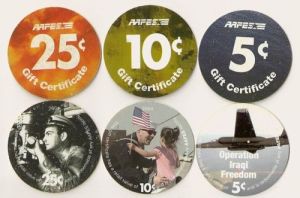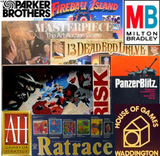 The Canada Games Company was somewhat of a major player in the board game market throughout the late 1980s and during the 1990s, publishing a variety of board games based on both original and licensed intellectual properties. To the casual observer, it appeared that the company sprang from thin air in 1984 with a full lineup of board games and toys, that included such classics as Balderdash, Ouija, and Kensington: The Great British Game. How could a company launch a full product line, seemingly out of the blue?
The Canada Games Company was somewhat of a major player in the board game market throughout the late 1980s and during the 1990s, publishing a variety of board games based on both original and licensed intellectual properties. To the casual observer, it appeared that the company sprang from thin air in 1984 with a full lineup of board games and toys, that included such classics as Balderdash, Ouija, and Kensington: The Great British Game. How could a company launch a full product line, seemingly out of the blue?
The answer, of course, is that the Canada Games Company was not born in 1984, but had a long history, albeit a relatively unknown one. The Canada Games Company was born on March 15, 1915, as a partnership between William Copp, Henry Legatt Thompson, and Arnold William Thomas. William Copp was already in the game business, being the “Copp” part of the Copp Clark Company. Both companies ran out of the same office. Later, in 1923, Copp chose to make the company a Limited corporation (adding the “Ltd.” to the name), and thereafter treated the Canada Games Company Ltd. as a subsidiary of Copp Clark. Canada Games was now an in-house label, owning the intellectual properties, but Copp Clark owned the manufacturing facilities.
The new Canada Games Company’s first product came shortly thereafter. Copp Clark had entered an agreement with the International Novelty Company to publish Ouija in Canada (the first coming as early as 1892). Sometime between 1915 and 1919, the first Ouija game branded with the Canada Games Company’s logo was produced. (Many games of this era did not include a date of manufacture on the box. We know that the legal eagles at William Fuld, Inc. sent Canada Games letters in 1919, demanding they stop publishing Ouija, so the date of the first Canada Games Ouija game must be between its creation and these letters. Ouija made the company a great deal of money, so naturally, they ignored the letters completely, and ultimately won the legal battle decades later. But I digress.) Later games published under the Canada Games Company brand included: Coast To Coast (1922), The All Star Hockey Game (1937), and Kensington (1979).
The fortunes of the Canada Games Company were tied to those of Copp Clark, so it could have been the end of the road for the company in 1982, when Copp Clark sold all its game and puzzle properties, including the entire Canada Games Company division, to Albert Diversified Limited. Rather than attempting to publish board games under the Albert Diversified brand, the new company Borg’d itself, changing its name to Canada Games Company, and the assimilation was complete.
This is the company most people remember when they see games published with the Canada Games logo. The “new” company started off with a bang, bringing out a made-in-Canada (invented by Laura Robinson and Paul Toyne) board game called Balderdash in 1984 (which subsequently sold 3.5 million copies and generated over $40 million in sales by 1990). In 1986, the company followed up this hit with VCR Hockey Night in Canada, a game using footage from the classic CBC Television broadcast. An even larger share of the gaming pie awaited, with the introduction of the An Evening of Murder series (attributed to game designer Cathy Miller of Pentalpha Games Corp. and Max Haines, a newspaper crime beat writer, although I admit to being somewhat hazy on who did what) in 1986, beginning with The Eternal Cruise, Flight 013, Beyond The Grave, and Forever Friends. Many more games in this series were released under the Canada Games logo, including Last Kiss (1989), Rodeo Round-Up (1989), Love and Marriage (1992), Resort To Murder (1993), Winner Take All (1994), and Terminal Espionage (1996).
More murder and mayhem were in store for Canada Games, as the company acquired the Canadian distribution rights for Decipher, Inc.’s line of How To Host A Murder (with Vincent Price on each box), publishing The Grapes of Frath, The Chicago Caper, The Class of ’54, The Last Train From Paris, and The Watersdown Affair (all in 1986), as well as Wall Street Scandal (1991). Canada Games also published the spinoff titles from the How To Host A Murder series, such as How To Host A Scavenger Hunt series (Animal Safari and Traveler Safari in 1991), and How To Host A Mystery: Star Trek The Next Generation (1993).
The early 1990s was a strong period for Canada Games. Games such as Hedbanz (1991), Dark World (1992), Dark World: Dragon’s Gate (1993), Dark World: Village of Fear (1993), Star Trek: The Next Generation: Klingon Challenge (1993), Beyond Balderdash (1993), Star Trek: The Next Generation: The Final Frontier (1993), as well as one of the flagship products from Copp Clark, Stock Ticker. All the while they also manufactured a large line of puzzles, some based on other licensed properties (such as Star Trek and Dynasty), others on sports figures (such as their hockey player series), and some on various scenic vistas or artist’s renditions. The Canada Games Company also ventured into the ever-changing toy industry, taking advantage of the resurgence of the yo-yo by securing the Canadian trademark and selling 1.5 million units (but also learning a lesson in Canadian trademark law along the way).
Not content with the Copp Clark intellectual properties and their own lineup, sometime around 1991, the Canada Games Company purchased the various Canadian trademarks and licenses of Waddington Saunders, giving them access to the any games and puzzles published previously under the Waddingtons House of Games logo. This included Ratrace, which was somewhat reimagined by Canada Games in 1994, as well as the already mentioned Dark World series.
With all this success, why don’t we see the Canada Games logo on new games on the store shelf? The quick answer is that the Canada Games Company went out of business in 1997. The shorter answer is this: Pogs. Sometime in the very early 1990’s, the world’s citizenry went insane, and began collecting smallish round cardboard tokens with various pictures on them (based on the cardboard inserts many dairies used to use to help seal old milk bottles). They would stack them up, and take turns hurling individual tokens (called “Pogs”) at the stack, picking up and setting aside the ones that fell down, taking turns until the entire stack was gone. This was no small thing: Pogs were EVERYWHERE. At one point, the U.S. Military used them as a substitute currency. The World Pog Federation held global championships to determine who was the best Pog player on Earth. This was a BIG THING.
The Canada Games Company executives wanted a piece of that action, and got into Pogs in a big way. And so they did, producing a wide variety of Pog sets. Unfortunately, the Pog craze died faster than their inventory depleted. It’s been speculated that this put the company in a cash crunch, with unsalable inventory and a need for cash. By 1997, the company was $11 million in debt and needed a cash infusion, but all efforts to find an investor willing to take a chance on the “feast or famine” toy market fell short. It was the end of the line for the Albert family business, and the company was put into receivership by KPNG, to sell off its remaining assets. The made-in-Canada game company that had soared to such great heights was brought down by a lowly piece of cardboard, which should be a lesson to all toy makers to beware the capriciousness of the market, and never, ever put all your Pogs into one basket.
Dark World TV Commercial of Dubious Quality
Filed under: Board Game Companies We Have Known, Board Games, Retro Gaming | Tagged: Board Games, canada games, copp clark, dark world, gaming, stock ticker, waddingtons |















I have a game called “The Castle Cue and Ball Game” made by The Canada Games Co. Limited”. I am not able to find any information such as a date of manufacture. Has anyone heard of this game?
Hi, I have a 2 sided board game board- Parcheesi and Snakes and Ladders although it is split in half unfortunately. The Canada Games Co Limited is printed on one side. Would like to know more about it, if possible?
Does anyone know who acquired the rights to Stock Ticker after Canada Games went in to receivership?
Please advise if you still sell Feline Frenzy Puzzles. In particular I am looking for specifically the one puzzle with the (3) SIAMESE CATS IN CHINESE BOWL or any other puzzles that have siamese cats.
If these puzzles are available where can I order or purchase puzzles in Winnipeg?
Thank-You
Does anybody have a list of all Hockey puzzle produced by the Canada Games Company. Was a product catalog produce?
really enjoyed this, thanks. spurred on by recent find of The Lost Heir card game…a Canada Games effort from the 1920s altho’ my edition appears to be circa 1940s by which time under the Copp Clark imprimatur. Now intrigued to hunt down the 1920s (?) book that inspired the original game! Thanks again.
Thanks! Very well done. Found this on my search re: a 1940s version of The Lost Heir card game…earlier versions attributed to Canada Games but by the time of mine it’s given as Copp Clark. Thx again!
Great Blog, great historical background on Canada Games. Collected “POGS” made by STANPAC in Smithville, Ontario during the 90’s. Still looking for World Pog Federation classic caps made by STANPAC for Canada Games and other companies in Canada.
I have an old copy of The Night Before Christmas, published by Canada Games Co Ltd. Could you tell me anything about it? Its a soft cardboard , brightly painted cover with Santa, holding a sack of toys from his waist up. Background of rooftop and yellow moon behind.
Do you still have the board game called Rommuli? I have the game but it has worn out.
Do you know when CGC issued their version of Tiddley-Winks? I have seen the game on display in the Edward Steves Homestead Museum in San Antonio, Texas. The house was built in 1877.
I’m looking for a game that was made by Canada Games. It’s a board cribbage game. You have a board where you place cards on to make runs, pairs, 15 2’s ect. and you count on a regular crib board. Anyone know where I can get one.
great blog with great information